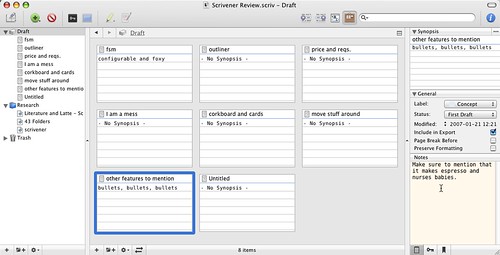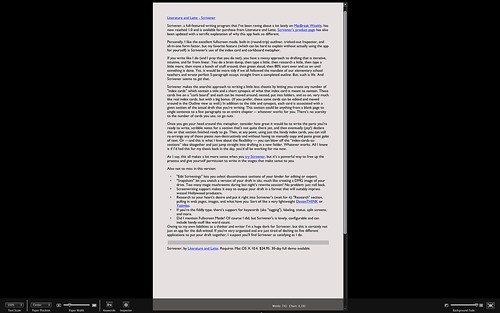Merlin’s weekly podcast with Dan Benjamin. We talk about creativity, independence, and making things you love.
Scrivener: Powerful OS X app for writers
Merlin Mann | Jan 21 2007
Literature and Latte - Scrivener Scrivener, a full-featured writing program that I've been raving about a lot lately on MacBreak Weekly, has now reached the 1.0 milestone and is available for purchase from Literature and Latte. Scrivener's product page has also been updated with a terrific explanation of why this app feels so different. Personally, I like the excellent fullscreen mode, built-in (round-trip) outliner, tricked-out Inspector, and all-in-one form factor, but my favorite feature (which can be hard to explain without actually using the app for yourself) is Scrivener's use of the index card and corkboard metaphor. If you write like I do (and I pray that you do not), you have a messy approach to drafting that is iterative, intuitive, and far from linear. You do a brain dump, then type a little, then research a little, then type a little more, then move a bunch of stuff around, then groan aloud, then 80% start over and so on until something is done. Yes, it would be more tidy if we all followed the mandate of our elementary school teachers and wrote perfect 5-paragraph essays straight from a completed outline. But, such is life. And Scrivener seems to get that. Scrivener makes the anarchic approach to writing a little less chaotic by letting you create any number of "index cards" which contain a title and a short synopsis of what that index card is meant to contain. These cards live on a "cork board" and each can be moved around, nested, put into folders, and so on, very much like real index cards, but with a big bonus. (If you prefer, by the way, these same "cards" can be edited and moved around in the Outline view as well.) In addition to the title and synopsis, each card is associated with a given section of the actual draft you're building. This section could be anything from a blank page to a single sentence to a few paragraphs to an entire chapter -- whatever works for you. There's no scarcity to the number of cards you use, so go nuts. Once you get your head around this metaphor, consider how great it would be to write the parts you're ready to write, scribble notes for a section that's not quite there yet, and then eventually (yay!) declare this or that section finished and ready to go. Remember, at any point, using just the handy index cards, you can still re-arrange any of those pieces non-destructively and without having to manually copy and paste great gobs of text. Or -- and this is what I love about the flexibility here -- you can blow off the “index-cards-as-sections” idea altogether and just jump straight into drafting in a new folder. Whatever works. All I know is if I'd had this for my thesis back in the day, you'd all be working for me now. As I say, this all makes a lot more sense when you try Scrivener, but it's a powerful way to free up the process and give yourself permission to write in the stages that make sense to you. Also not to miss in this version:
My only substantial bitch about Scrivener so far is that it's maybe not ideal for fast web writing. Although it has many configurable export options, I haven't found an easy way to export super-simple plaintext or html that still honors the formatting and links you created back in the app's native RTF style. The HTML it does put out can be pretty janky, littered with the kinds of whacky Owing to my considerable liabilities as both a thinker and writer, I'm already a huge dork for Scrivener. But be assured that this is certainly not an app exclusively for employment by the dull-witted. Even if you're already an organized thinker but are just tired of dashing to five different applications to tape your draft together, I suspect you'll find Scrivener as satisfying as I have. Scrivener, by Literature and Latte. Requires Mac OS X 10.4. $34.95. 30-day full demo available. Download now. 53 Comments
POSTED IN:
 I checked out the release...Submitted by Saket Kulkarni (not verified) on January 29, 2007 - 12:25pm.
I checked out the release version of Scrivener after reading about it on this blog entry. I was hooked right away! Up until now I've been trying to work out a writing workflow using all kinds of geeky solutions. For the moment, I'd been working in TextMate and using the LaTeX bundle with pdflatex to process my Great Unpublished Novel into a readable PDF format. To make it even more interesting and "efficient", I just started using subversion to keep track of the various incarnations of my project. Now, Merlin, before you start in on me with all of your Kung Fu, Meditation and Sexual...erm...scratch that last one, I will fully admit to spending more time lately tweaking my great writing 'workflow' than on actually getting any writing done. Along comes this post, and Scrivener! I realize it's still early days for this bit of software, but there's a clear eye toward the writing process here. The interface is simple enough to not distract you too much from your main task: writing. The synopsis cards, key word tagging, the outliner, and the binder all make it easy to keep track of the things that need tracking. But they are, for the most part, optional and non-intrusive. The full screen mode is exactly what the doctor ordered and, although WriteRoom supplies this same functionality (and TextMate can be made to behave similarly using the Mega Zoom bundle), none are as elegantly functional as Scrivener's implementation. The slider for background transparency, the text zoom, the paper-width slider....bliss! Then, for the geek in me, there's the snapshot function that makes it easy for me to create instant versions of my project (sure, it lacks the advanced functionality of subversion, but this is an app for writers and keeps it simple but functional). Also, there is the support for multimarkdown (which can get me back to a LaTeX file and thence to PDF!!). Wow! I even like the export functions available for the text files...although I'm wondering if it might not become more powerful if they were to use a 'smart rules' interface like the one for iTunes smart playlists or for Mail.app mail rules. That would allow me to print out my document in any number of creative and powerful ways. Hmm...I might drop them this suggestion over on Literature and Latte... @Maria Langer I know this isn't a full response to your question, but Scrivener (.scriv) 'files' are actually Unix packages. To quote the Scrivener tutorial: "Just a quick note on the file format, by the way: .scriv files are actually UNIX packages (which is to say, folders that just happen to look like files). This means that you can ctrl-click on them in the Finder and select “Show Package Contents”. If you do this, you will (reassuringly, I hope) discover that all of your work is actually stored as multiple RTFD and XML files. " So there's no need to worry about being locked into their file format. I had a quick peek inside a Scrivener package and confirmed I could reach my text via a text editor although, it can be vexing to have to piece together your document from all the loose RTFD files. Also, I'm not entirely certain if it is possible to access all the extra/meta data such as keywords, research, etc. I hope that addresses a part of your question, at any rate. Merlin: Thanks for introducing me to another awesome Mac app! » POSTED IN:
|
|
| EXPLORE 43Folders | THE GOOD STUFF |


